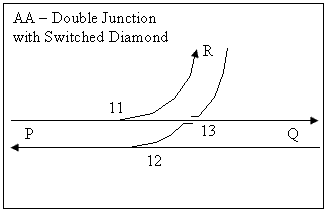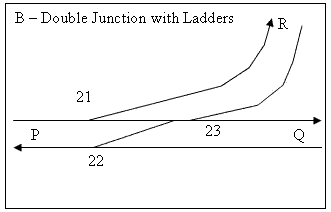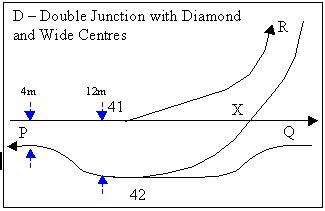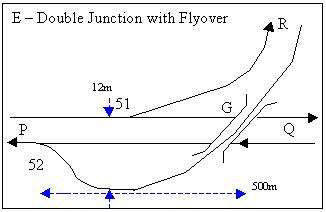Double junction

A double junction is a railway junction where a double track railway splits into two double track lines. Usually, one line is the main line and carries traffic through the junction at normal speed, while the other track is a branch line that carries traffic through the junction at reduced speed.
A number of configurations are possible.
At grade
Diamond

The simplest and oldest arrangement consists of two turnouts and a fixed diamond crossing. Because the diamond needs to be relatively coarse, say 1 in 8, the curve radius is necessarily small, leading to a speed of perhaps 25 km/h. This type of junction is common on street-running tramways, where speeds are quite low and junction must fit into the available road space. Because the points are close together, the entire junction can be controlled by the mechanical point rodding of a single signal box.
Signal passed at danger (SPAD) protection — A train from R to P with 12 points reverse is protected from a train from P doing a SPAD by 11 points also lying reverse. A train from P to Q is NOT protected from a train from R doing a SPAD.
Switched diamond

The fixed diamond can be replaced with a switched diamond, which eliminates the gap in rails at the K-crossing, which allows a higher speed if the geometry is poor. However, switched diamonds are not a perfect solution to the K-crossing problem, as the switches are very coarse compared to the finer switches of a turnout, and require high maintenance. The additional ends are also awkward to control unless power operated point machines are used.
Ladder

An improved junction replaces the diamond with turnouts, which can be of as fine an angle as possible, so that this junction can carry branch traffic at high speed. This configuration assumes power operation of the points, as high speed turnouts are generally not suitable for mechanical operation. The high speed turnouts may require more than one point machine each. The turnouts can have no superelevation while the curve in the branch can; therefore the radius in the turnouts must be greater than the radius of the curve in the branch.
Since the ladder type junction requires much more length, diamond type junctions can only be converted into ladder types if there is room and no bridges, tunnels, or platforms in the way.
- SPAD protection
Essentially the same as for a double junction with diamond.
Examples include Harris Park railway station, Sydney.
Single lead Left Hand

A single lead junction is used where traffic density is lower, and moves one of the turnouts on the main line onto the branch. This may reduce the number of turnouts on the main line that are subject to wear. The diamond crossing is a wearing component due to the gaps in the K-crossings, and this configuration eliminates the diamond.
Space permitting, a single lead junction may be a stage towards construction of a higher speed ladder junction.
Risk
However, unlike in the ladder, branch trains in opposite directions can collide head-on at 32 if either one passes a signal at danger (SPAD). This has contributed to fatal accidents, e.g. in the UK at: Glasgow Bellgrove on 6 March 1989 and Newton on 21 July 1991.[1] These risks can be reduced by trap points, ATP or TPWS.
Risk amelioration
The hazard of the short section of single line with the single lead junction would be reduced if there were two red signals protecting it. British practice mostly has one protecting signal. New South Wales practice mostly has two red signals protecting such a junction, albeit at the cost of some reduction in train headway. Alternatively, trap points could be installed to protect the single line. Two signal protection is a relatively easy way to reduce these risks, and would have been helpful at the Ladbroke Grove rail crash. A comprehensive ATP system would also help.
Single lead Right Hand
A right hand single lead junction cannot protect against a collision should the Q-P train overrun the signal protecting the junction, and this is not ameliorated by reverting to a double junction.
Diamond and wide centres

A double junction with a diamond can have its speed limit raised if the track centres are widened from say 4 m to say 12 m to allow for a fixed coarse-angled diamond crossing with fine-angled turnouts. Examples are at Cabramatta, Australia and Wootton Bassett, England.
If the legs of the coarse crossing X are straight and flat, then this arrangement eliminates the need for switched diamonds and their inconvenient moving parts.
- SPAD protection
Essentially the same as for a double junction with diamond.
Grade separated
Flyovers


A double junction can be grade separated so that there is no flat crossing, reducing conflicts and reducing congestion. Flyovers require a lot of space both lengthwise and crosswise, and cannot always be built. Flying junction example at Aynho Junction. Diving junctions such as at Chatswood are a variant. Weaver Junction is the oldest flying junction in the United Kingdom and perhaps the world. See also Aynho Junction.
- SPAD protection
Because the diamond crossing or equivalent is eliminated, one of the potential SPAD hazards is also eliminated, leaving just the merging junction hazard.
See also
- Railway station layout - stations often include double junctions
References
- ↑ Hall, Chapter 6: Hidden Dangers - Single Lead Junctions
- Hall, Stanley (1999). Hidden Dangers: Railway Safety in the Era of Privatisation. Sheperton: Ian Allan. ISBN 0-7110-2679-3.